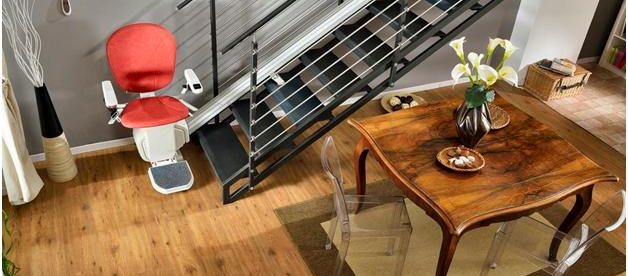Everything You Want To Know About Stairlifts Is Right Here
Ever wondered if you can make stairs at home accessible for your elderly loved ones or other family members whose disabilities may prevent them from going up and down the stairs? Our friends over at Home Healthcare Adaptations have created a comprehensive guide that will walk you through the types of stairlifts, mechanics of how they work, who would need them, their costs, benefits, and safety features. Watch this quick video below to understand the basics of stairlifts. Text version is below the video.
What are stairlifts?
- Stairlifts are lifting devices powered by electricity which enable people with limited mobility to travel ip and down staircases with ease.
- They are equipped with a chair or a platform, the selection dependent upon the specific user’s needs.
How does a stairlift work?
- A stairlift moves along a rail which is fitted to the stairs and a motor is used to move the stairlift along a track.
- This motor is powered by a battery which charges automatically on a continual basis. It can be charged at either the top or the bottom of the stairs and will always be sufficiently charged so that it will never cut out halfway along the stairs.
- Stairlifts are easy to operate. They are controlled by a small toggle or joystick on the armrest – simply direct this up or down to move the stairlift.
- If you have 2 or more people using the same stairlift, it comes as standard with 2 remotes that will enable a user to summon it up/down the stairs.
Who is most likely to need a stairlift?
- Someone with multiple sclerosis or arthritis.
- Someone who has undergone hip replacements.
- Someone whose mobility is affected following an operation.
- An elderly person with notable frailty.
Types of Stairlifts
- Straight stairlifts are the simplest of all stairlift types and can fit the majority of staircases that have a straight flight from bottom to top.
- Curved stairlifts are used when the staircase for which it is being fitted has one or more turns.
- Perch (or standing) stairlifts are ideal for those who find it difficult to bend their knees and sit. The seat is smaller and positioned higher than with a standard stairlift, allowing the user to perch rather than sit.
- Outdoor lifts have similar features to indoor stairlifts, in addition to being waterproof and able to withstand extreme conditions.
How much do stairlifts cost?
- Straight stairlifts cost in the region of €1,800 (supply and maintenance) and can be fitted within 2-3 days of being ordered.
- Curved stairlifts are more expensive, as they are made to measure. They usually cost between €5,000 and €6,000, while manufacture and fitting could take 5-6 weeks from the initial order date.
Stairlift safety features
- Sensors to detect potential obstructions.
- Lockable on/off switch to deactivate the stairlift when not in use.
- Mechanical and electrical braking systems to braking systems to bring the stairlift to a smooth, safe stop.
- Safety belts on the seat/perch to prevent users from falling off the stairlift.
- Swiveling footplates to bridge the gap between the stairlift and the top of the stairs.
Benefits of Stairlifts
- Provide a safe, comfortable method of moving freely around your home.
- Promote a substantial degree of independence.
- No need to walk up and down stairs to fo to an upstairs bathroom or bedroom.
- You can continue living in your current home without the need to relocate.
- Extremely easy to use – all you need to do to operate a stairlift is move a control pad.
- Easy to fold and unfold so as to be unobstrusive when not in use.
- Very affordable – running costs are similar to what you’d use in boiling a kettle
Source: Home Healthcare Adaptations
Read more here.


I’m glad that you mentioned that stairlifts are easy to use and all that is required to operate one is a simple control pad. My dad has a hard time walking and stairs have become really hard for him to navigate. This information you shared made me feel better about the possibility of getting them a stairlift.
The lifts helps you to keep your independence on your stairs while staying safe. The Stair lift is a high quality fixed handrail and a sliding supporting